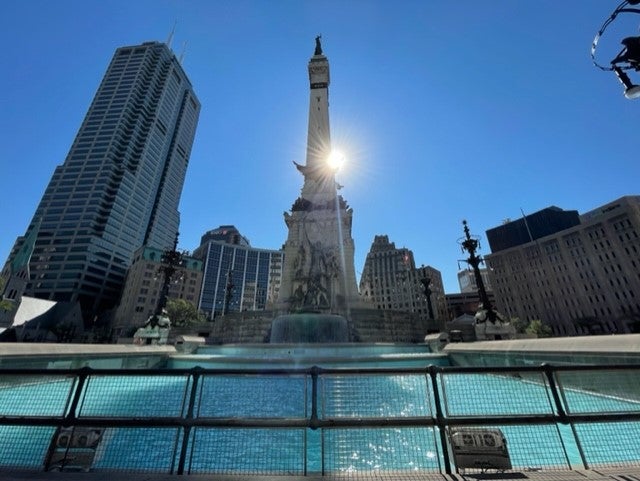Touring Indy’s Treasures: The Soldiers and Sailors Monument
The Indianapolis area is home to a number of “treasures” — interesting places, museums, and landmarks that make Indy special. Join News 8’s Hanna Mordoh on a tour of Indy’s treasures.
Part 1 |
INDIANAPOLIS (WISH) — Monument Circle is in the center of downtown Indianapolis, and at the center of Monument Circle is what many consider the city’s heart — the Soldiers and Sailors Monument.
“We are in the heart of the city and it is a great opportunity to come down and see what the city has been about through the years,” Kasey Zeronek, the director of volunteers and heritage experiences for Indiana Landmarks, said.
During the summer, Zeronek gives monthly one-hour tours of the one-of-a-kind monument.
“What I am thinking as I walk up is how smart the design of the monument is. So, it is the Soldiers and Sailors Monument, right? If you are new or you don’t remember what it is called…soldiers and sailors,” Zeronek said, pointing to the figures on the monument.
The Soldiers and Sailors Monument, along with its pools, fountains, and statuary, opened in May 1902. The monument stands 286 feet tall.
“It is just a little bit shorter than the Statue of Liberty, so it is a really impressive monument in the center of the city,” Zeronek said.
Before the monument was built, the center of the city was a bit undecided, according to Zeronek.
“When the city was designed by Alexander Ralston, this was actually supposed to be the governor’s house and it didn’t work out,” Zeronek explained. “So, we went through several iterations. It was a city park before it was the monument. It had the statute of Governor Morton in the middle and, after the Civil War, they decided, ‘Maybe we need to make a little bit more of a statement.’”
Zeronek says the monument was designed by a German architect named Bruno Schmitz during a competition to see whose design could embody the city of Indianapolis.
“Everything in the Circle is actually designed as part of the monument,” Zeronek said. “A part of frontier life — so he has bison and then, if you look up, you can also see bears.”
The bears look like those seen in Germany, according to Zeronek, and are not necessarily the black bears native to Indiana.
But the gray oolitic limestone that makes up the monument is native to Indiana — it came from Owen County.
The soldiers and sailors depicted on the monument are in memory of the Hoosiers that came before us, according to Zeronek.
“It was something that the community came together to put up as a way to honor the soldiers and sailors who had fought in the 19th-century wars,” Zeronek said.

The figures represent the Hoosiers that served in the War of 1812, the Mexican War, the Civil War, the Frontier Wars, and the Spanish-American War as well as the American Revolution.
Along with the history, Zeronek and the other tour guides hope people take away a greater message from the monument: the purpose and the sacrifice of Indiana’s soldiers and sailors.
“I think it is important for people to know this was the first monument in the country that was dedicated to the common soldier,” Retired Air Force Brig. Gen. J. Stewart Goodwin, executive director of the Indiana War Memorials Commission, said.
Goodwin, in his role with the commission, understands the monument’s importance.
“The part of honoring the soldiers is very important because they never got that kind of recognition,” Goodwin said. “I think it is also important to know that when it was built, there was only one monument in the whole country that was taller than this monument, and that was the Washington Monument in Washington, D.C.”
The monument became a National Historic Landmark in 1973. The details honoring Indiana’s servicemembers are evident both near and far.
“On one side, you can see the cavalrymen and the infantrymen, and on the back side, you have a sailor and an artilleryman,” Goodwin said.
The inside of the monument is no longer open to the public, according to Goodwin. The artifacts inside needed to be better preserved and are now in the Indiana War Memorial.
“We went through a major renovation with moving the Eli Lilly Civil War Museum,” said Goodwin.
For now, the inside is off-limits. However, Goodwin says, there is hope that it will one day reopen with a gift shop that sells Indiana merchandise only.
In the meantime, Goodwin says, the monument is also just a place to gather. The 7,000 gallons of water moving across the spillway fountains every minute, helps people do just that, according to Goodwin.
“The fountains are a very important part because they add a sense of calmness and they are a meeting place,” Goodwin said.
And even over 100 years ago, it was clear if you build it, they will come.
“It doesn’t matter what (gathering) it is, people want to have it here, you know, because this is the icon,” Goodwin said.


